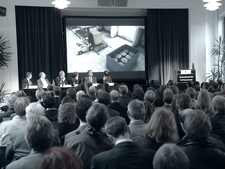All options are feasible
BfS presented feasibility and impact studies on the decommissioning of the Asse II repository.
end 2010.10.02
location Schöppenstedt

![]() Experts presented their results to the interested public
Experts presented their results to the interested public
On 2 October the Federal Office for Radiation Protection (BfS) presented the feasibility and impact studies on the decommissioning of the Asse II repository in a public informative meeting in Schöppenstedt. In his welcoming speech, BfS President Wolfram König made clear that the expert reports had shown that all options were feasible, both technically and under the aspect of radiation protection.
In front of an audience of about 300 persons in the Schöppenstedt Eulenspiegelhalle, the experts presented their results with regard to three of the decommissioning options under discussion: Retrieval of the radioactive waste, their relocation into deeper areas of Asse, or the complete backfilling of the facility with a special type of concrete. Each lecture was preceded by a short movie visualising the respective decommissioning option.
Regarding retrieval of the waste, the time frame prognosticated by the experts varies between 2.8 years required for a partial retrieval (70 %) of the waste and 14.6 years for a 100-% retrieval of all waste including decontamination of the mine. For a relocation of the complete radioactive inventory into deeper rock formations below the actual mine experts have calculated a time frame of up to 18 years, since long-term safe, new emplacement areas need to be explored first. A complete backfilling of the mine would require about eight years.

![]() BfS-President Wolfram König in Schöppenstedt
BfS-President Wolfram König in Schöppenstedt
Citizens used the opportunity to pose their specific questions to the experts, the focus being on the topics of radiation protection and long-term safety.
All options will be implemented with the reservation that the rate of the solutions daily flowing into the mine will not extremely incease. For this case BfS already published an emergency plan at the beginning of July.
Until the end of the year, BfS wants to evaluate the expert reports on the three decommissioning options with the help of the published catalogue of criteria and present a decision. In this evaluation, BfS uses all the professional competence it has as the authority competent for disposal. This includes in particular radiation protection, geology, mining, operation of a nuclear facility. A key issue to BfS is the protection of the staff, residents, and the environment. The entire decision-making process takes place with broad participation of the general public and with the utmost transparency.
Address
38170 Schöppenstedt

